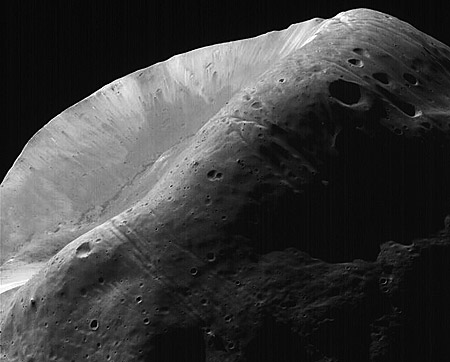
 How did Phobos get its Death Star dent?
How did Phobos get its Death Star dent?
Ah, Phobos, the doomed moon of Mars. Pock-marked and ill-shaped, all covered in strange striations. Phobos, that lonely little collection of rock and dust, gamely moving in sad circles around its parent planet, the same one with whom it is destined to collide one day. Surely, this is one of the solar system’s strangest little tales.
There’s more than a hint of mystery to Phobos. First spotted in 1877 by U.S. astronomer Asaph Hall, Mars’ innermost moon has long been the subject of scientific debate. What makes up Phobos’ inner core? How did it get those intriguing parallel grooves on its surface? And what about that eerie little shadow of a monolith sticking out of Phobos’ surface like a gravestone? (The subject of the Canadian Space Agency’s fascination a decade ago, no less, when the CSA proposed an unmanned mission to land a spacecraft right next to Phobos’ monolith.)
And, of course, there’s the huge Death Star dent in Phobos’ side called Stickney crater.
The defining feature of poor Phobos, Stickney is 9 km across -considerable, in that Phobos itself is only 22 km in diameter. Like a big punch in the gut, Stickney has warped Phobos, almost to the point of breaking it apart. But how exactly did Stickney come about? For a small space object like Phobos to absorb such a huge blow would be a miracle, really. But miracles do happen, apparently, as researchers from the Lawrence Livermore National Laboratory (LLNL) in Livermore, California, have created a computer simulation which explains how an asteroid or comet could have so disfigured Phobos without blowing it up.
“We’ve demonstrated that you can create this crater without destroying the moon if you use the proper porosity and resolution in a 3D simulation,” says Megan Bruck Syal of the LLNL planetary defense team and co-author a new study on Phobos. “There aren’t many places with the computational resources to accomplish the resolution study we conducted.”
By one of the team’s simulated scenarios, an impact object 250 metres across could have hit Phobos at a speed of six km per second and kicked in the appropriately-sized divot. The study also allowed the researchers to speculate on the origin of Phobos’ parallel striations. Past theories have held that the grooves must have been the result of the same impact that created Stickney, but the new study’s modelling shows that impact fracture patterns would not end up looking much like the straight, long, parallel lines we see on Phobos today.
The LLNL planetary defense team is using its research to simulate asteroid impacts in order to investigate ways to possibly avoid such events on Earth in the future. “Something as big and fast as what caused the Stickney crater would have a devastating effect on Earth,” Syal said. “If NASA sees a potentially hazardous asteroid coming our way, it will be essential to make sure we’re able to deflect it.”
Meanwhile, Phobos, as scientists have concluded, keeps heading ever closer towards its own demise, with its orbit descending by about two metres every one hundred years, making a final meet-up with Mars imminent in 30 to 50 million years.
Leave a Reply
You must be logged in to post a comment.



 Share
Share Tweet
Tweet Share
Share




Comment